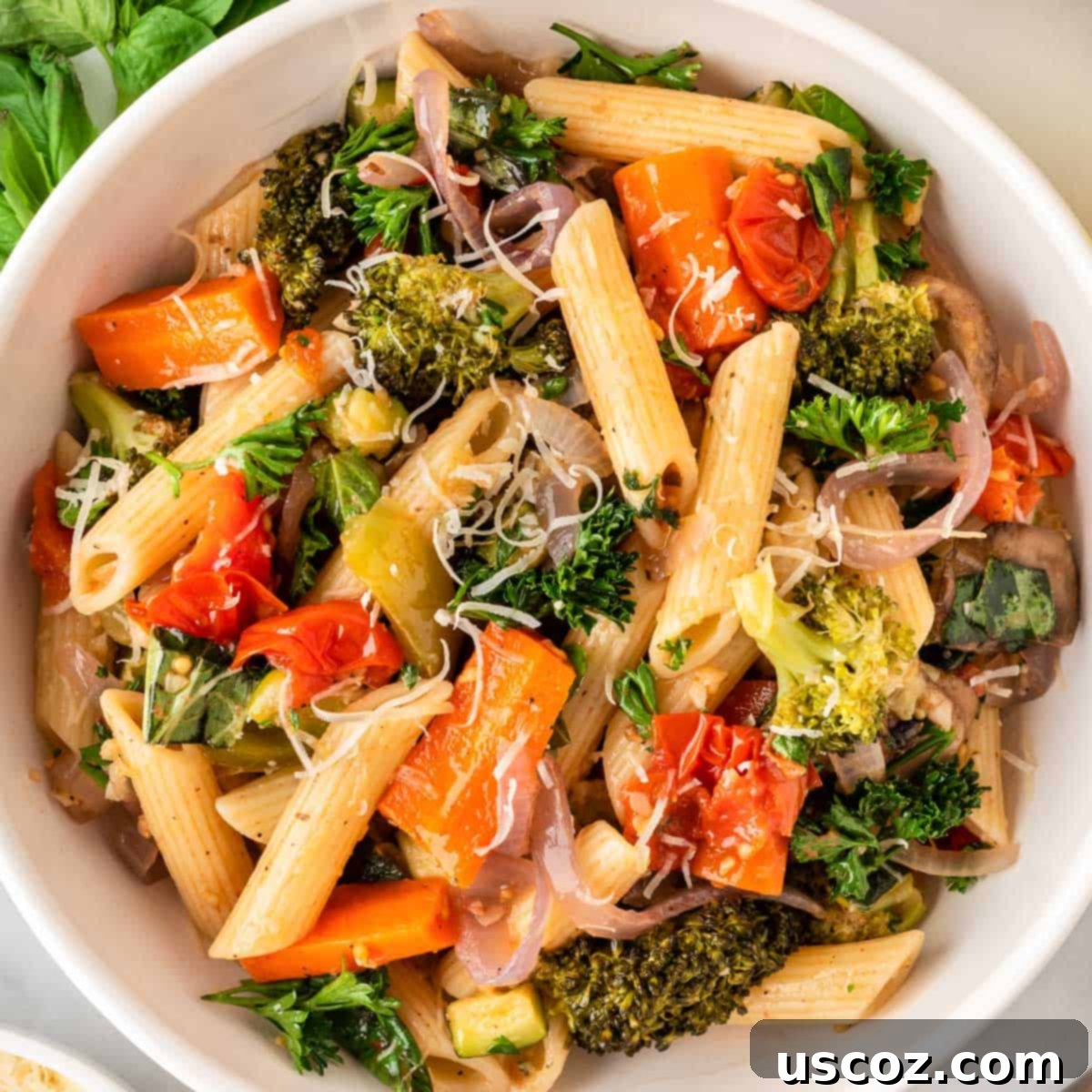The Best Roasted Vegetable Pasta: An Easy, Flavorful, and Healthy Dinner Recipe
This Roasted Vegetable Pasta is your go-to recipe for utilizing whatever seasonal veggies you have on hand. Infuse your pasta and vegetables with the vibrant flavors of fresh herbs and premium olive oil for a truly delicious and satisfying dinner!
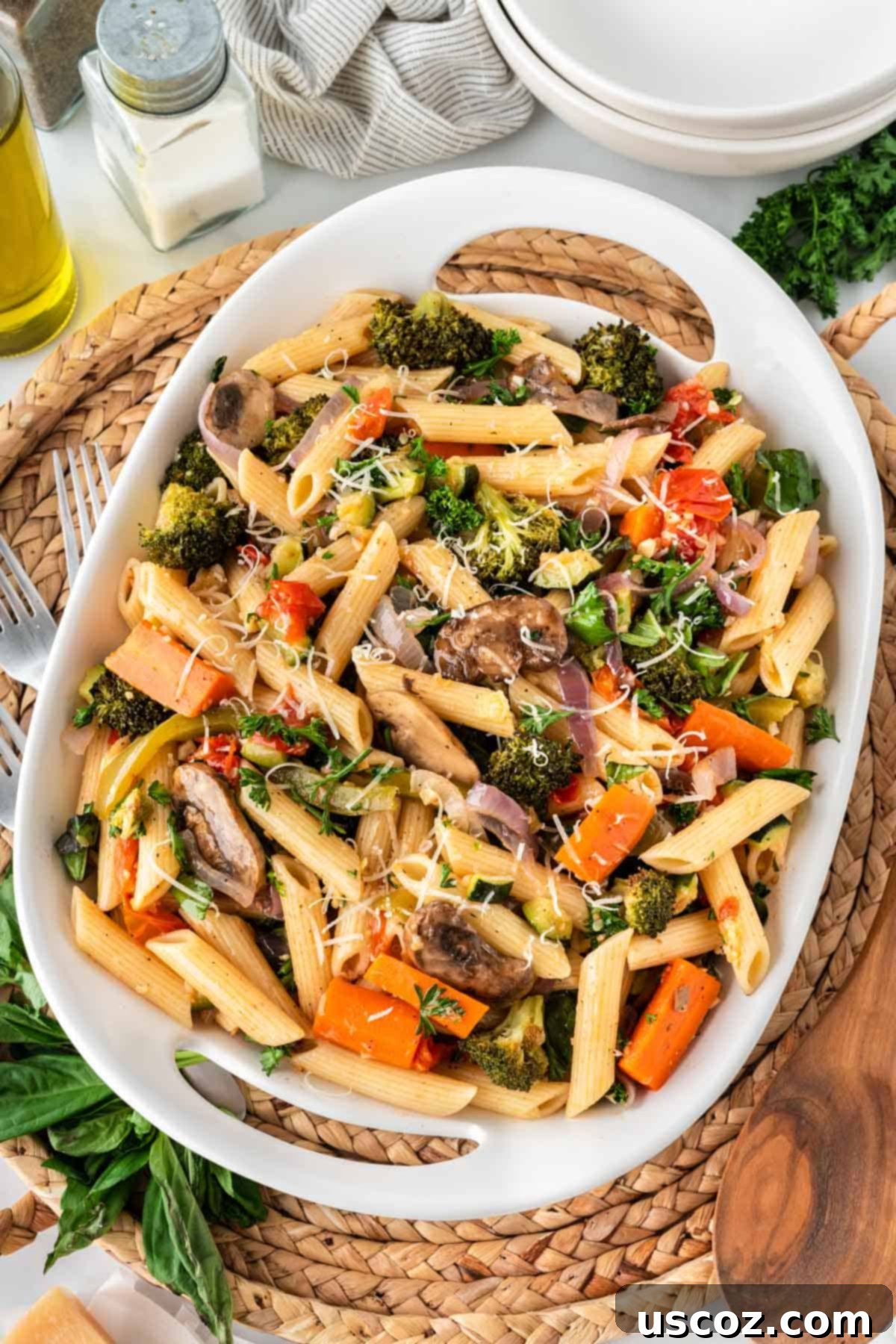
Why You’ll Love This Flavorful Roasted Vegetable Pasta
This roasted vegetable pasta recipe has become a true staple in our home, especially during the warmer months when fresh produce is abundant. It’s a dish I find myself returning to again and again, and for good reason! The magic lies in its simplicity and the incredible depth of flavor achieved by roasting fresh vegetables.
What makes this particular pasta dish so special is its remarkable versatility. You’re not tied to a specific list of ingredients; instead, you’re encouraged to use whatever vegetables you have on hand, transforming them into a vibrant and satisfying meal. Whether it’s a bounty from your garden, a farmers’ market haul, or just a few forgotten items in your fridge, they all find a happy home in this pasta.
Think of it as a roasted vegetable primavera that you can customize to your heart’s content! Much like our popular Veggie Lover’s Rigatoni, the fresh, perfectly roasted vegetables are undeniably the stars of the show. Seasoned generously with aromatic fresh basil and parsley, and finished with a generous sprinkle of freshly grated Parmesan (which, trust me, is an absolute must!), this dish delivers a flavor explosion that’s both comforting and invigorating.
It’s not just delicious; it’s also a fantastic way to enjoy a healthy, vibrant, and incredibly easy dinner any night of the week. Plus, the roasting process brings out a natural sweetness and a slight caramelization in the vegetables, adding layers of complexity to every bite.
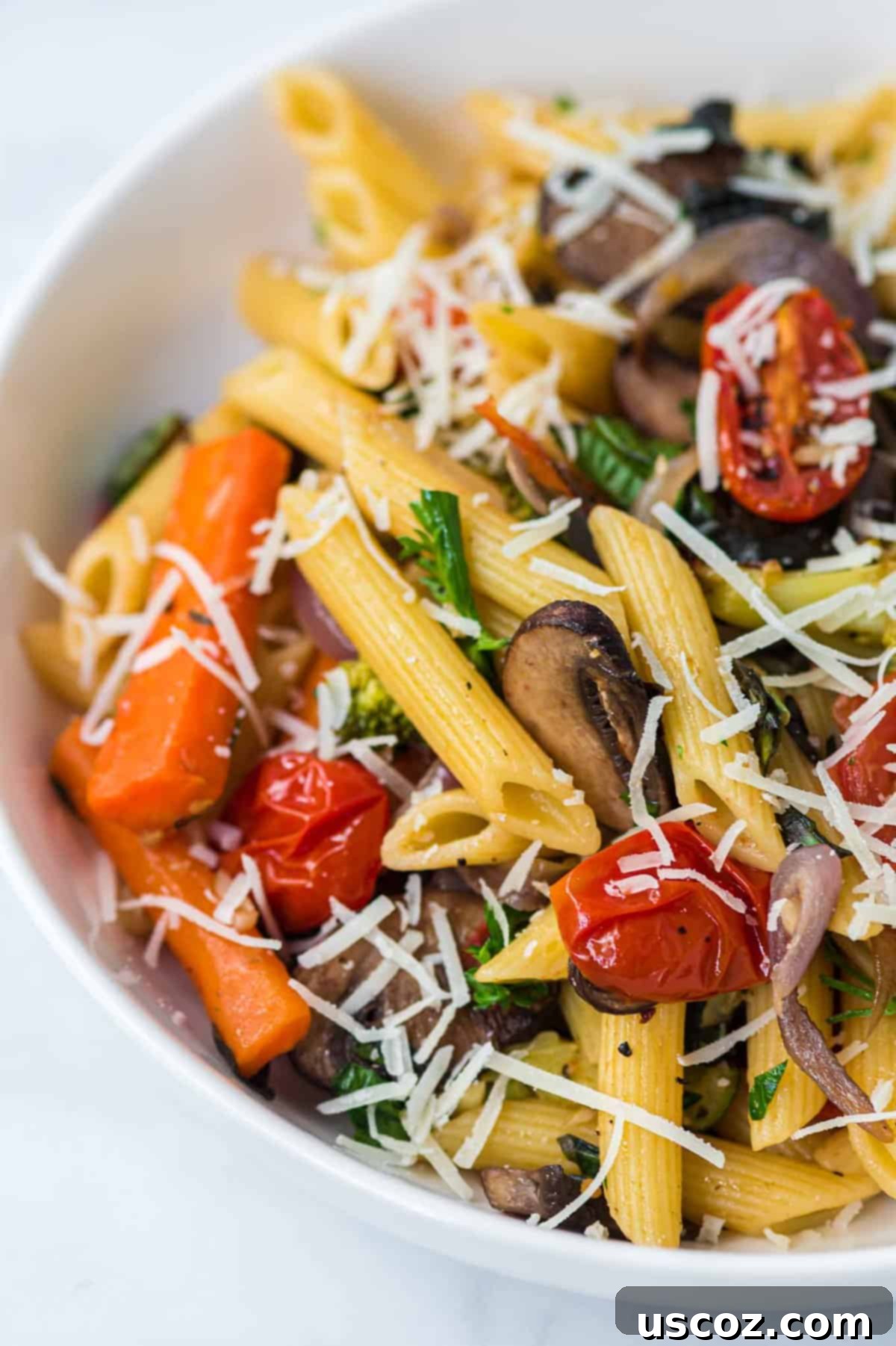
Ingredients & Notes
Here’s a breakdown of the key ingredients that make this roasted vegetable pasta so incredibly delicious, along with some helpful notes and substitution ideas:
- Penne pasta: While penne is excellent for catching all the flavorful roasted veggies and sauce, feel free to use any shape of pasta you prefer. Bowties, rigatoni, ziti, spaghetti, or even whole wheat or gluten-free pasta varieties work wonderfully.
- Green bell pepper: Adds a crisp, slightly bitter note that balances the sweetness of other roasted vegetables. You can easily substitute with red, yellow, or orange bell peppers for a sweeter profile and a pop of color.
- Red onion: Offers a beautiful color and a slightly sharper, more pungent flavor when raw, but mellows and sweetens beautifully once roasted. If you prefer a milder taste, yellow onion or even shallots would be good alternatives.
- Zucchini: A classic summer squash that roasts up tender and delicious. Yellow squash or other summer squashes can be used interchangeably.
- Mushrooms: We recommend button or cremini mushrooms, which absorb flavors wonderfully and develop a rich, earthy taste when roasted. Slice them evenly for consistent cooking.
- Whole carrots: When cut into strips or coins, carrots sweeten significantly during roasting. We do not recommend using baby carrots as they tend to burn easily and have a different texture.
- Cherry tomatoes: These little bursts of flavor are fantastic when roasted, becoming juicy and slightly caramelized. Grape tomatoes or even chopped Roma tomatoes would also work well.
- Broccoli: Breaks down beautifully, offering tender florets with slightly crispy edges. If you have it on hand, cauliflower is an excellent substitute and cooks similarly. Broccolini is another great option.
- Fresh parsley and basil: These are not just garnishes; they are the true flavor heroes of this dish! Their bright, aromatic qualities elevate the roasted vegetables and bring a fresh, vibrant finish. Don’t skip them for the best results!
- Garlic: Freshly minced garlic is essential. It provides a warm, pungent depth of flavor that marries all the ingredients together. Avoid pre-minced garlic for the freshest taste.
- Olive oil: A good quality extra virgin olive oil is key for roasting the vegetables and dressing the final pasta. It adds a fruity, peppery note that enhances the overall flavor.
- Parmesan cheese: Freshly grated Parmesan cheese is an absolute must! Its salty, nutty, and umami-rich flavor rounds out the dish perfectly. Pre-grated cheese simply doesn’t compare.
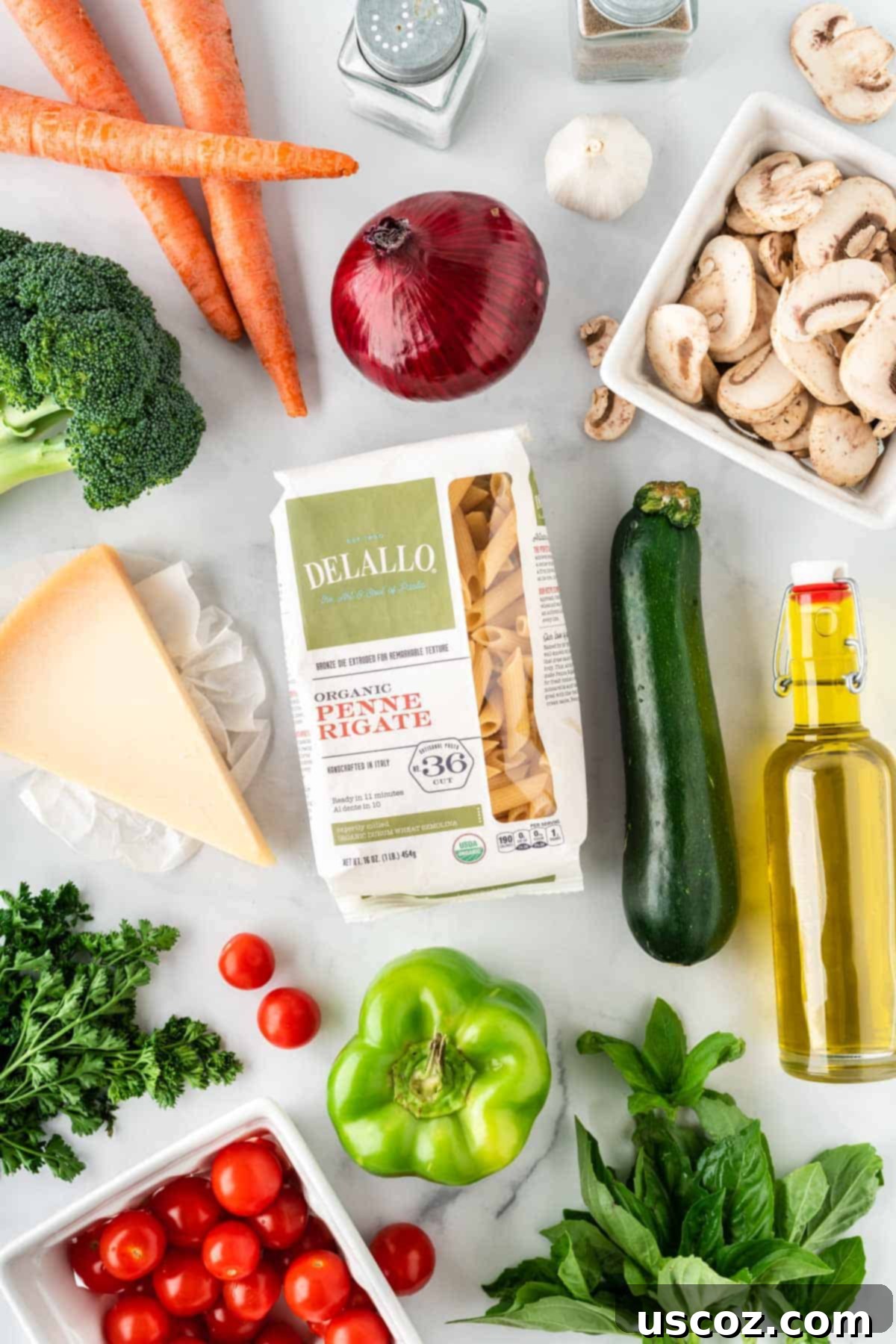
How to Make Roasted Vegetable Pasta: Step-by-Step Guide
Creating this flavorful roasted vegetable pasta is incredibly straightforward. Follow these steps for a wholesome and delicious meal:
Step 1: Prepare and Roast the Initial Vegetables
Begin by preheating your oven to 425°F (220°C). On a large sheet pan, spread out your green bell pepper, red onion, carrots, zucchini, and broccoli. Drizzle these vegetables generously with olive oil, then season them with a good pinch of salt and freshly ground black pepper. Use your hands to thoroughly toss everything together, ensuring each piece is well coated in the oil and seasonings. This even coating is crucial for achieving that desirable golden-brown caramelization. Place this sheet pan into your preheated oven and roast for 15 minutes.
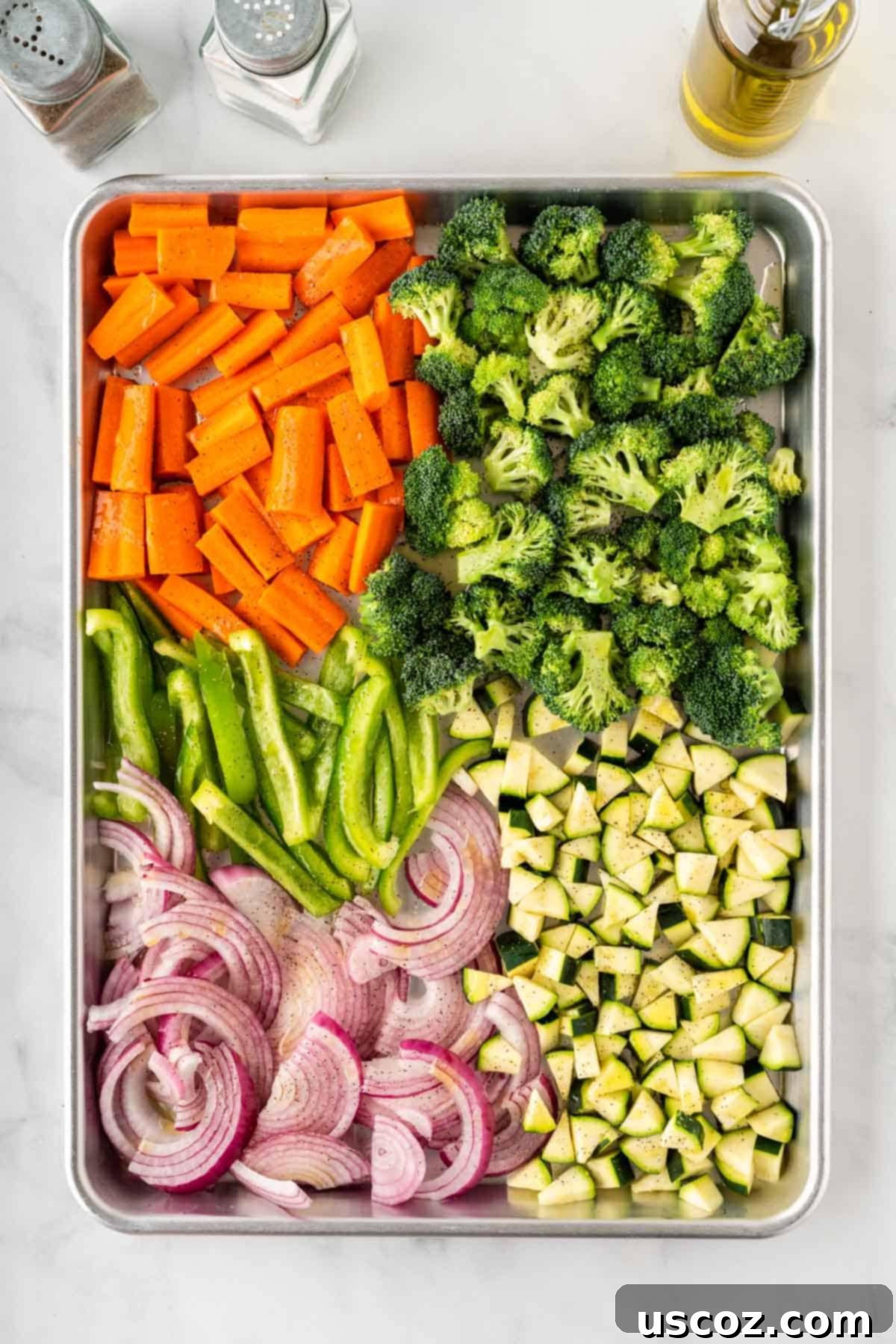
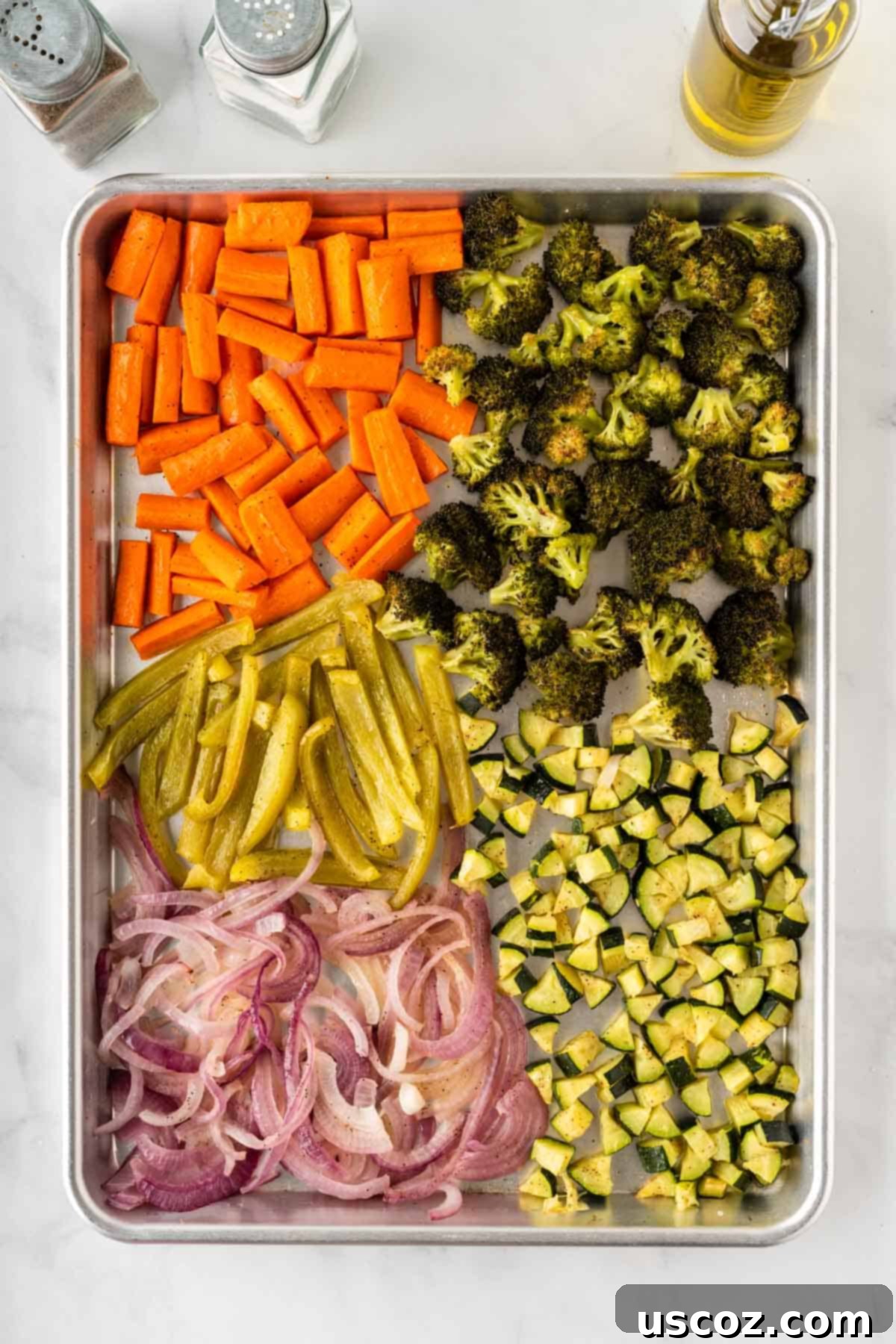
Step 2: Add Remaining Vegetables and Continue Roasting
While the first batch of vegetables is roasting, prepare your second sheet pan. Halve a small container of cherry tomatoes and slice 8 ounces of mushrooms. Drizzle these with olive oil, and season with salt and pepper. Once the initial 15-minute timer for the first sheet pan is up, carefully remove it from the oven, give the vegetables a good stir, and then place both sheet pans into the oven. Continue roasting all the vegetables for an additional 15 to 30 minutes, stirring them once or twice during this period. The goal is for all the vegetables to be tender, slightly browned, and bursting with roasted flavor. The exact cooking time may vary based on your oven and how finely you’ve chopped your vegetables.
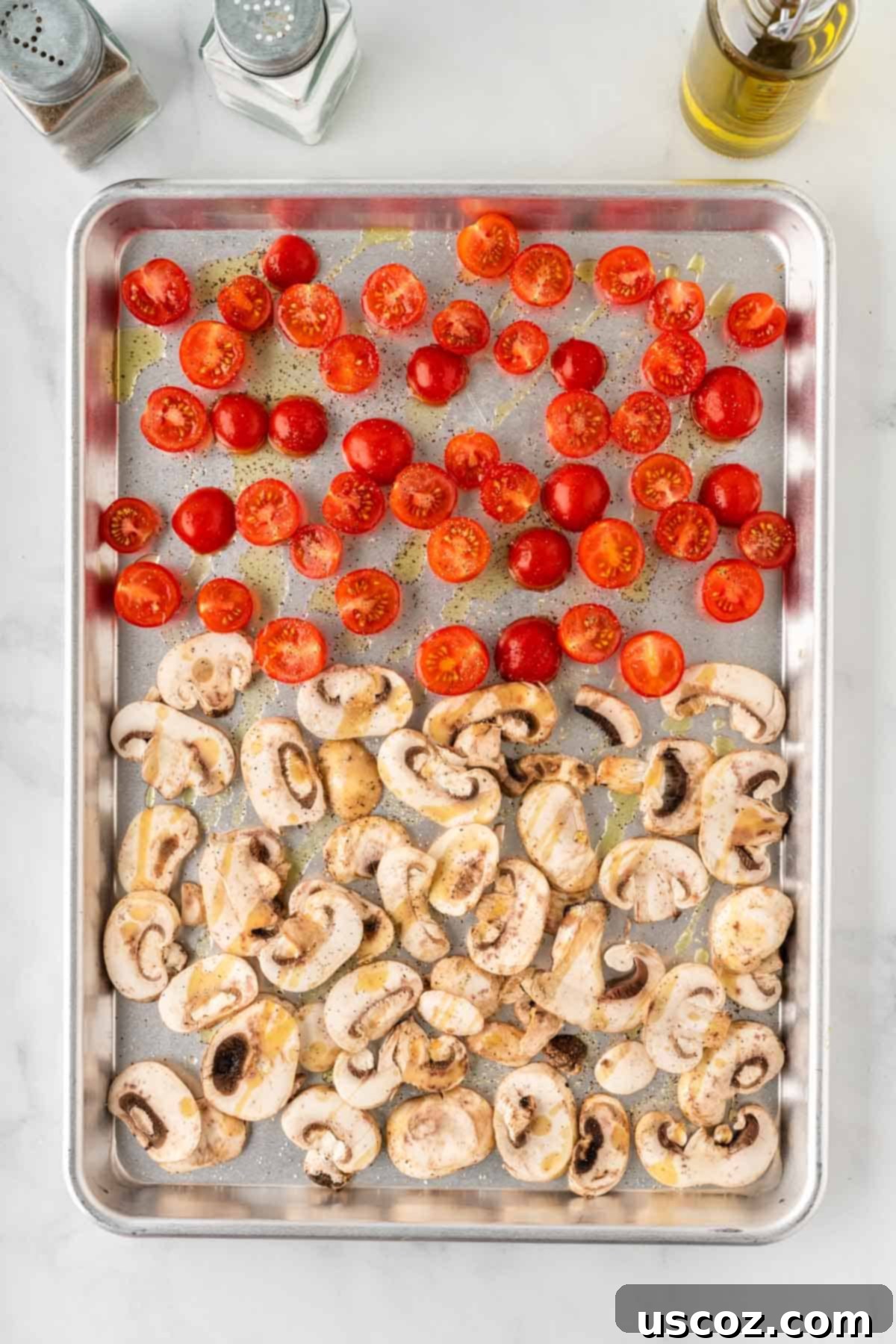
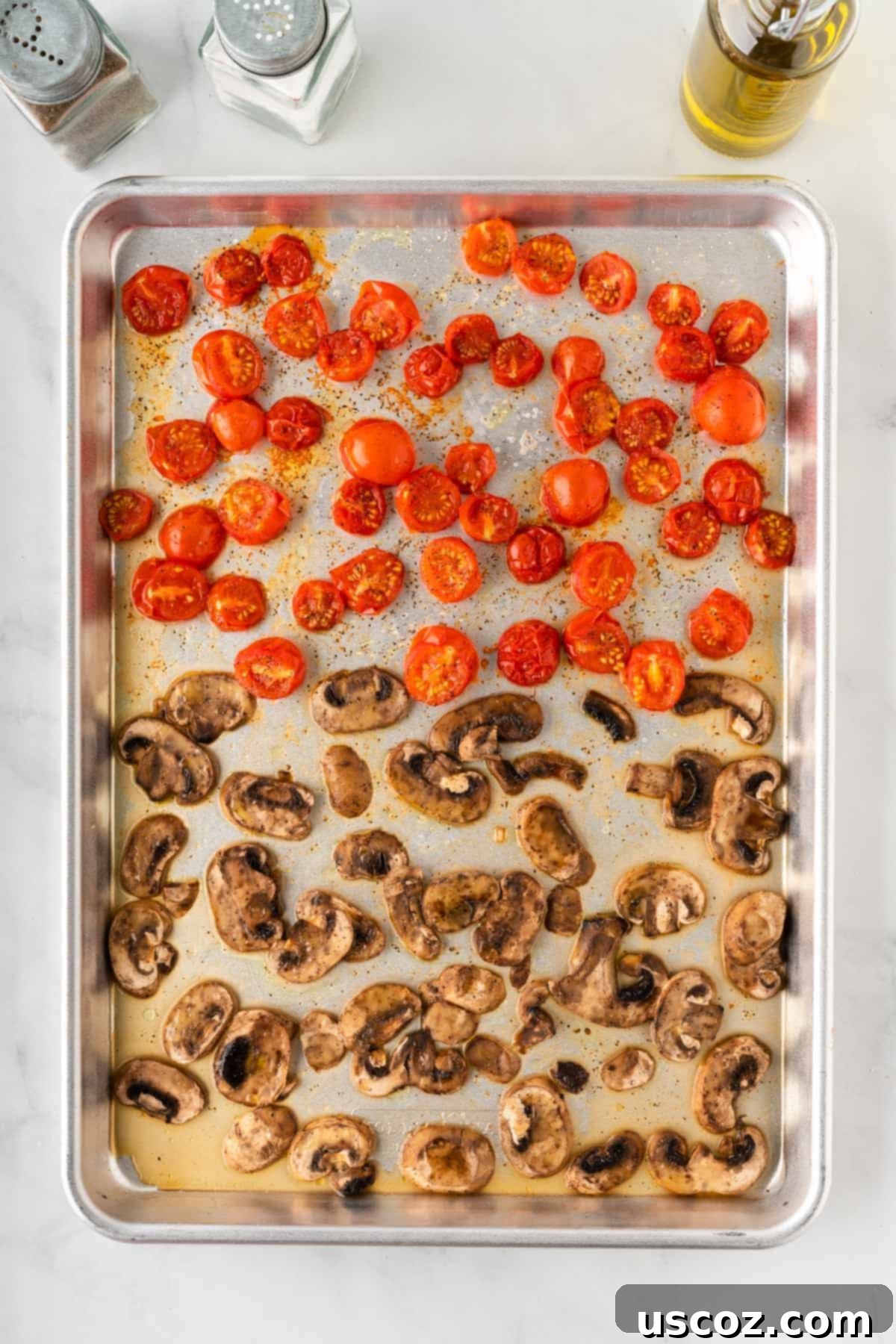
Step 3: Cook the Pasta
While the vegetables are roasting, bring a large pot of salted water to a rolling boil. Add one pound of your chosen pasta and cook according to package instructions until it reaches an al dente texture – firm to the bite. Once cooked, drain the pasta thoroughly, reserving about a cup of the starchy pasta water (you might need it later to loosen the sauce). Leave the drained pasta in the strainer for a moment.
Recipe Tip: Choosing Your Pasta
We opted for penne pasta in this recipe because its tube shape and ridges are perfect for capturing all the delicious roasted vegetable bits and light sauce. However, this recipe is incredibly adaptable! Feel free to use any pasta shape you love. Think bowties (farfalle), rigatoni, ziti, elbow noodles, fusilli, or even spaghetti or fettuccine for a different experience. The key is to choose a pasta that complements the texture of the roasted vegetables.
Step 4: Infuse Garlic Flavor
Using the same pot you used for the pasta (less cleanup!), heat about 1 teaspoon of olive oil over low heat. Add your freshly minced garlic and stir gently for 1-2 minutes. Be careful not to burn the garlic, as it can turn bitter very quickly. You’re looking for it to become fragrant and slightly softened, releasing its wonderful aroma.
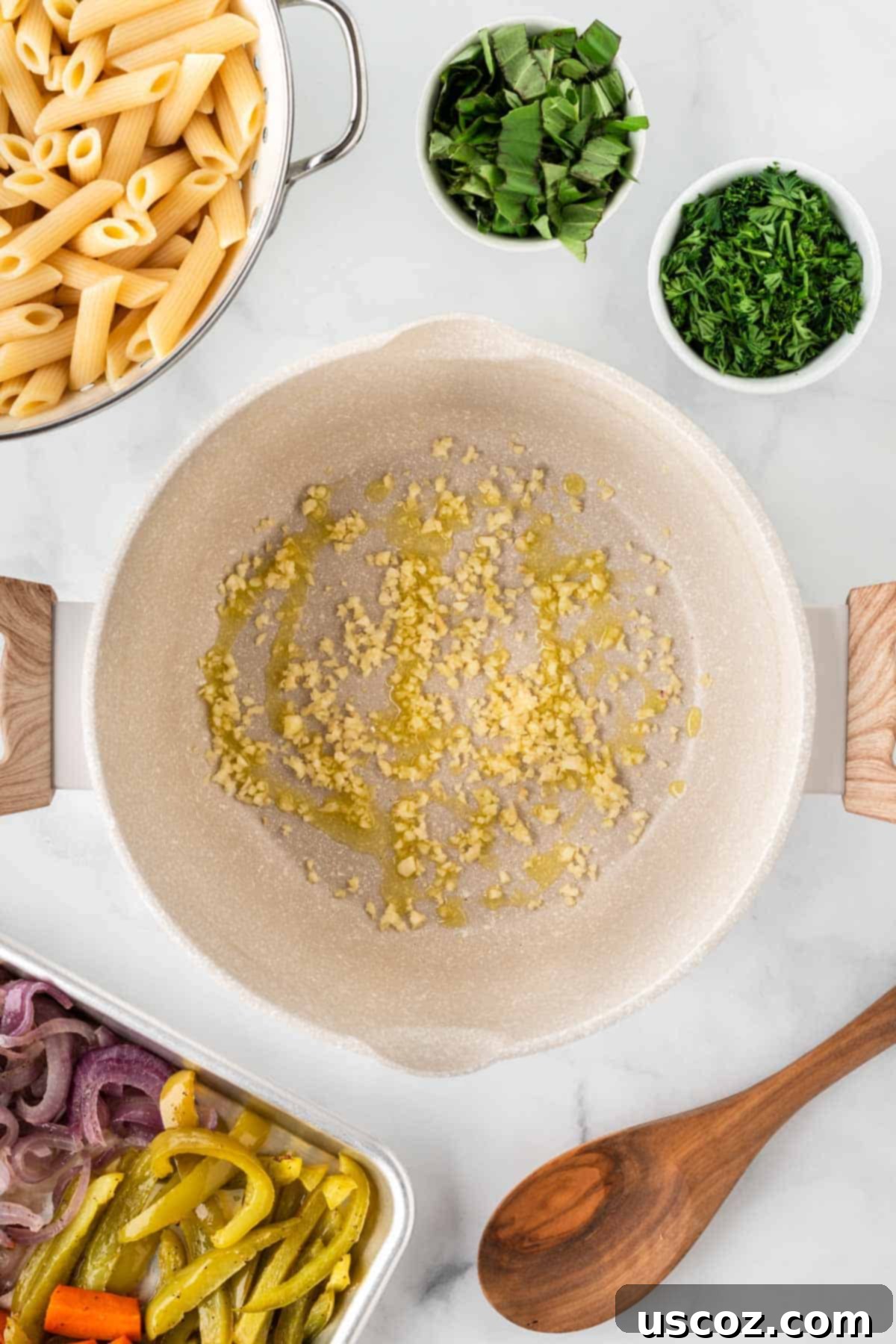
Step 5: Combine and Season
Return the drained pasta noodles to the pot with the fragrant garlic. Add in all of your beautifully roasted vegetables and the fresh herbs (parsley and basil). Toss everything gently to combine, allowing the flavors to meld. Taste and adjust the seasoning with additional salt and pepper as needed. If the pasta seems a little dry, add another small drizzle of olive oil or a splash of the reserved pasta water to achieve your desired consistency. The pasta water contains starch that helps the sauce cling to the noodles. You can serve this roasted vegetable pasta as is, and it’s naturally vegan!
Joy’s Note: The Power of Fresh Herbs
I typically use about 1/3 cup of fresh parsley and 1/2 cup of fresh basil for this recipe, but you can certainly use more or less depending on your preference. However, please don’t skip the herbs! Fresh herbs are incredibly flavorful and truly accentuate the delicious taste of the roasted veggies, adding a bright, aromatic dimension that dried herbs simply cannot replicate. They are the secret ingredient to taking this dish from good to absolutely outstanding.
For an extra layer of savory goodness, I personally love to finish each serving with a generous amount of freshly grated Parmesan cheese on top. There is just nothing quite like Parmesan grated directly from the block; its sharp, salty notes are key to rounding out this wholesome and satisfying dish!
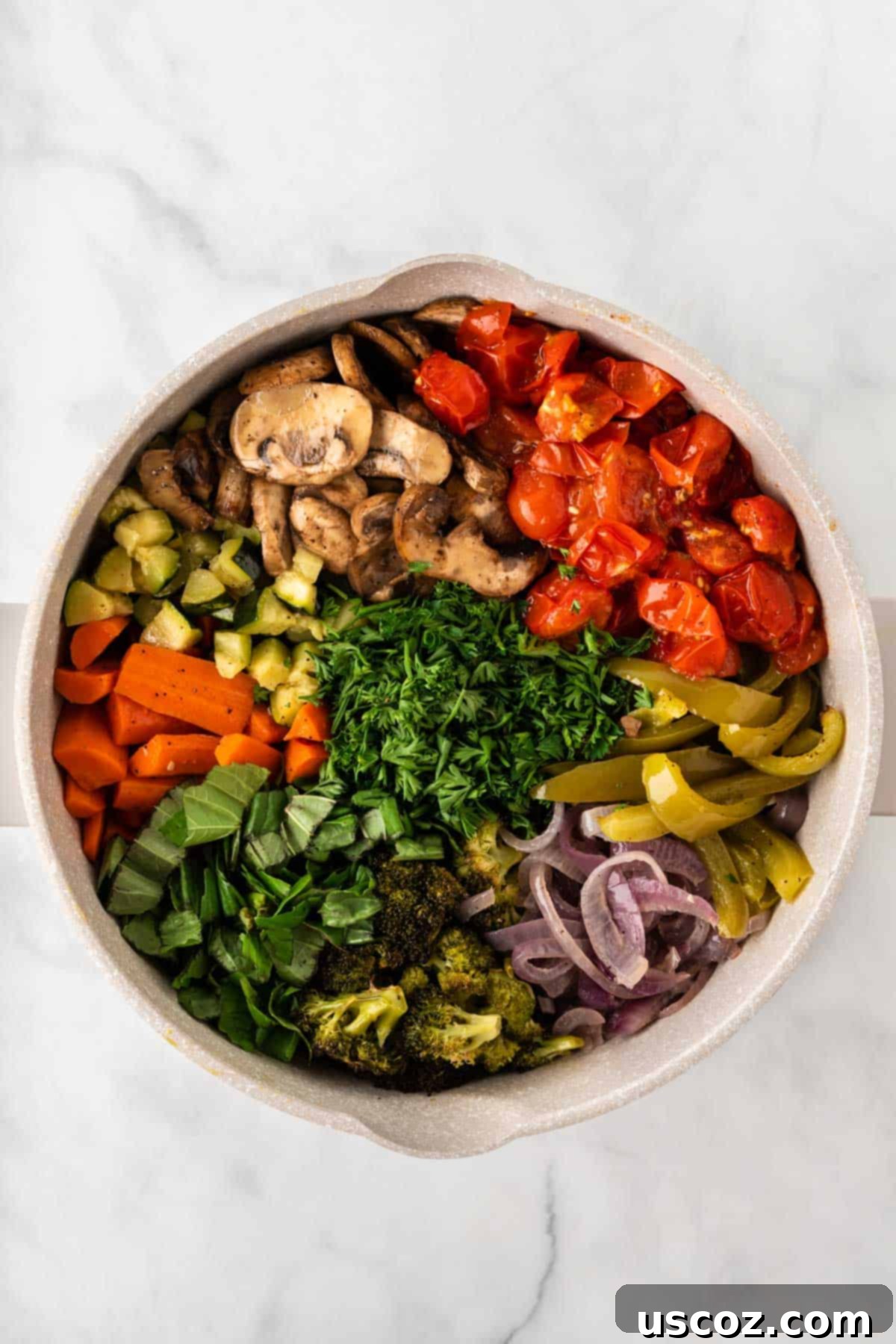
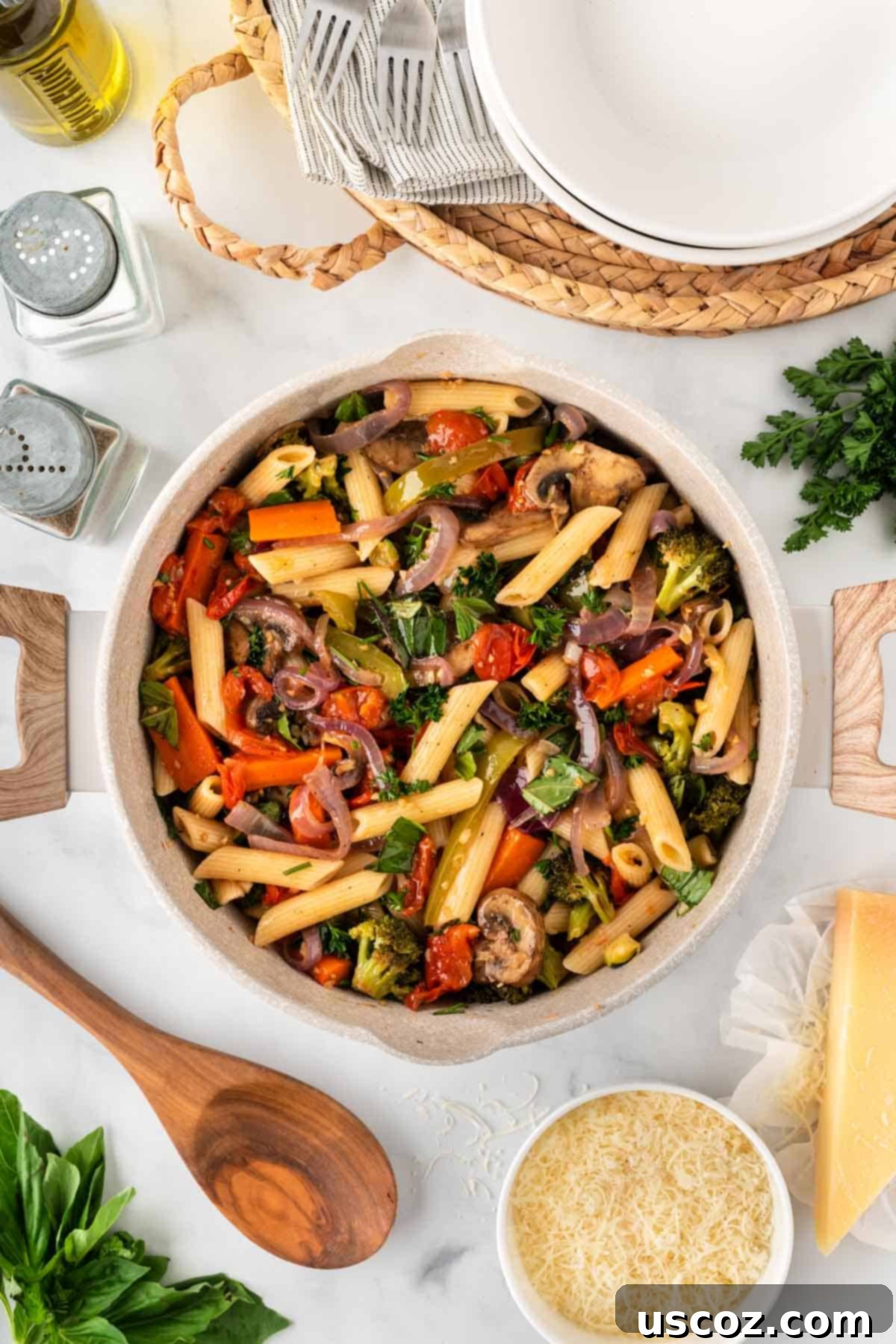
Expert Tips for Perfect Roasted Veggie Pasta
Achieving the most delicious roasted vegetable pasta is all about a few simple techniques. Here are some expert tips to ensure your dish turns out perfectly every time:
- Don’t Overcrowd the Pan: This is perhaps the most crucial tip for roasting vegetables. If your sheet pan is too crowded, the vegetables will steam instead of roast, resulting in soggy, rather than caramelized, results. Use two sheet pans if necessary to give your veggies plenty of space.
- Chop Veggies Uniformly: Aim for roughly similar sizes for your harder vegetables (like carrots and broccoli) to ensure they cook evenly. Softer vegetables like zucchini and bell peppers can be slightly larger.
- High Heat is Key: Roasting at 425°F (220°C) allows the vegetables to brown and caramelize beautifully on the outside while becoming tender on the inside. This high heat unlocks their natural sweetness.
- Season Generously: Don’t be shy with salt and pepper before roasting. The high heat of the oven can mellow flavors, so a good initial seasoning is important. You can always adjust at the end.
- Fresh Herbs Make a Difference: While dried herbs have their place, fresh basil and parsley bring an unparalleled brightness and aroma to this dish. Add them at the very end to preserve their delicate flavors.
- Freshly Grated Parmesan: As mentioned, this is a game-changer. The intense, salty, and nutty flavor of freshly grated Parmesan adds a depth that pre-grated varieties simply can’t match.
- Cook Pasta Al Dente: Pasta should be firm to the bite. It will continue to absorb some liquid and soften slightly when mixed with the hot vegetables. Overcooked pasta can become mushy.
- Reserve Pasta Water: This starchy liquid is your best friend! If your pasta feels a bit dry after mixing, add a tablespoon or two of the reserved pasta water to create a light, cohesive sauce that clings to the noodles.
Variations & Customizations
One of the best things about this roasted vegetable pasta is how easily it adapts to your pantry, preferences, and dietary needs. Here are some ideas to make it your own:
- Use Different Veggies: The beauty of this recipe is its flexibility! Experiment with other seasonal favorites. Cauliflower, asparagus (add in the last 10-15 minutes of roasting), summer squash, Brussels sprouts, or even different colored bell peppers (red, yellow) would all be absolutely delicious. Hardier root vegetables like parsnips or sweet potatoes can also be roasted, but might need a bit more time in the oven.
- Use Another Cheese: If Parmesan isn’t your favorite, or if you’re looking for a different flavor profile, try another cheese. Tangy feta crumbles would add a lovely Mediterranean touch. Creamy goat cheese would melt beautifully, while a sharper Pecorino Romano could offer an even bolder flavor. For a dairy-free option, nutritional yeast can mimic a cheesy flavor.
- Mix Up the Herbs & Spices: While basil and parsley are fantastic, feel free to experiment with other fresh herbs like oregano, thyme, or even a hint of fresh rosemary. Want some heat? Add in a few red pepper flakes to the roasting vegetables or directly to the finished pasta for a spicy kick. A drizzle of pesto at the end can also add a rich, herbaceous layer.
- Try Another Pasta Type: Beyond penne, the possibilities are endless! Chickpea pasta or lentil pasta can boost the protein content, while gluten-free pasta ensures it’s suitable for those with dietary restrictions. Larger shapes like rigatoni noodles, ziti, or cavatappi can hold up well to the roasted vegetables, while thinner strands like linguine or fettuccine offer a different mouthfeel.
- Add Protein: To make this dish a more substantial meal, consider adding a protein. Grilled chicken breast, sautéed shrimp, crumbled Italian sausage (pork or plant-based), or even plant-based options like roasted chickpeas, white beans, or pan-seared tofu would all complement the roasted vegetables wonderfully.
- Add a Touch of Acid or Sweetness: A splash of balsamic vinegar or lemon juice at the end can brighten the flavors. For a hint of sweetness, a drizzle of balsamic glaze or a sprinkle of sun-dried tomatoes can be delightful.
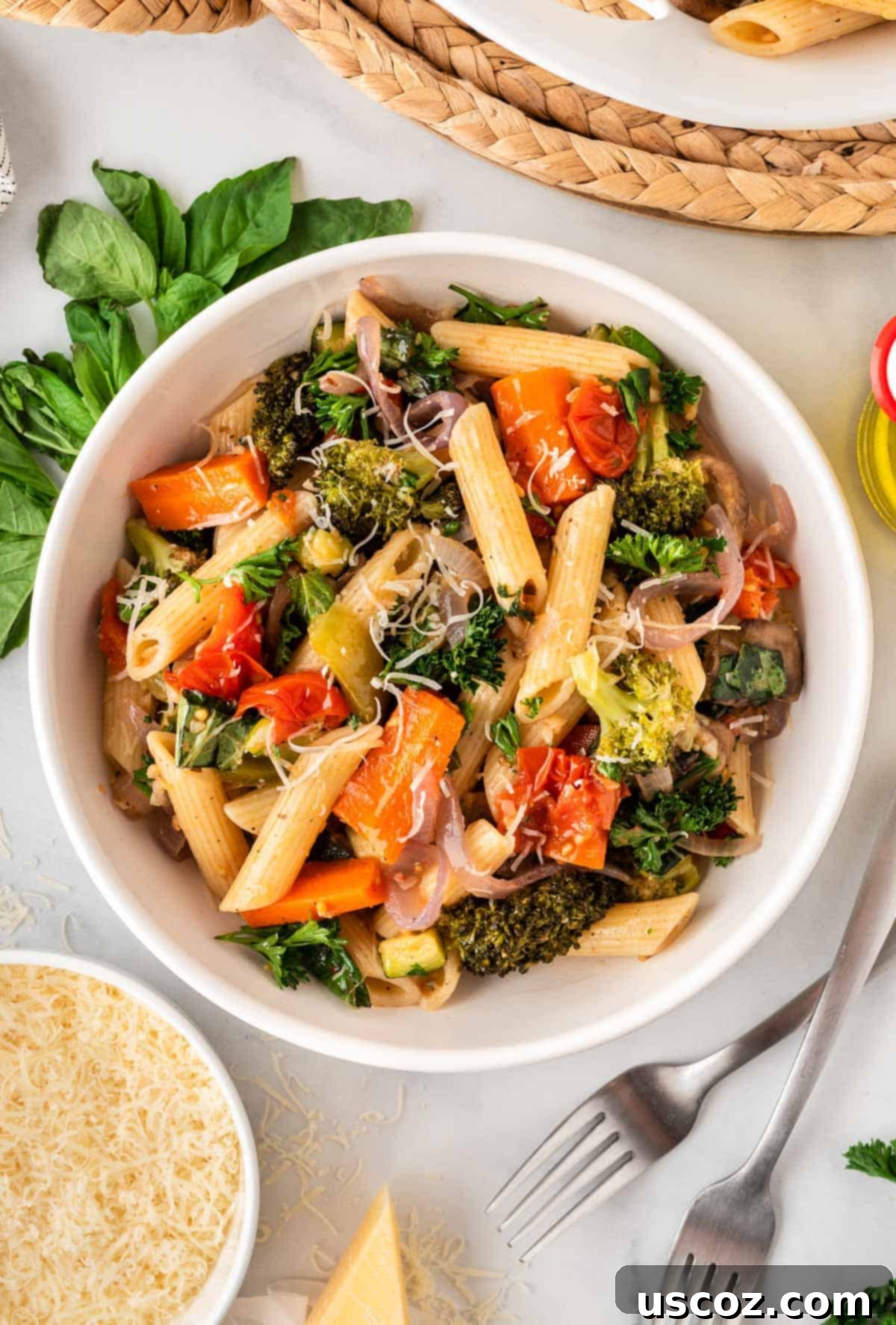
How to Serve This Delicious Dish
This roasted vegetable pasta is incredibly versatile, making it suitable for various meal occasions. Here are some ideas for how to serve it:
- As a Main Dish: With its abundance of flavorful vegetables and hearty pasta, this dish stands proudly as a satisfying main course on its own. It’s perfect for a meatless dinner night, offering plenty of nutrients and vibrant flavors.
- With a Protein Boost: If you’re looking to add more protein to your meal, this pasta pairs beautifully with a variety of additions. Try serving it alongside perfectly grilled chicken, pan-seared shrimp, or flaky baked salmon. For plant-based protein, consider adding crispy roasted tofu, garlicky chickpeas, or cannellini beans.
- Accompanied by a Side Salad: A simple, crisp green salad with a light vinaigrette makes a refreshing accompaniment, balancing the richness of the pasta.
- With Crusty Bread or Garlic Bread: Serve with a side of warm, crusty bread or homemade garlic bread to soak up any remaining delicious olive oil and herb juices.
Storing Leftovers & Reheating
This roasted vegetable pasta makes for fantastic leftovers, perfect for a quick lunch or dinner the next day!
Storing: Any leftover pasta can be stored in an airtight container in the refrigerator for up to 3 days. Ensure it has cooled completely before sealing and refrigerating to prevent condensation.
Reheating: To reheat, you have a couple of options:
- Microwave: For a quick reheat, place a portion in a microwave-safe dish and heat on high for 1-2 minutes, stirring halfway through, until warmed through. You may want to add a splash of water or vegetable broth to prevent it from drying out.
- Stovetop: For best results, reheat leftovers in a large skillet over medium-low heat. Add a tablespoon or two of water or vegetable broth to loosen the pasta and vegetables, stirring occasionally until heated through. This method helps to retain the pasta’s texture and prevents it from sticking.
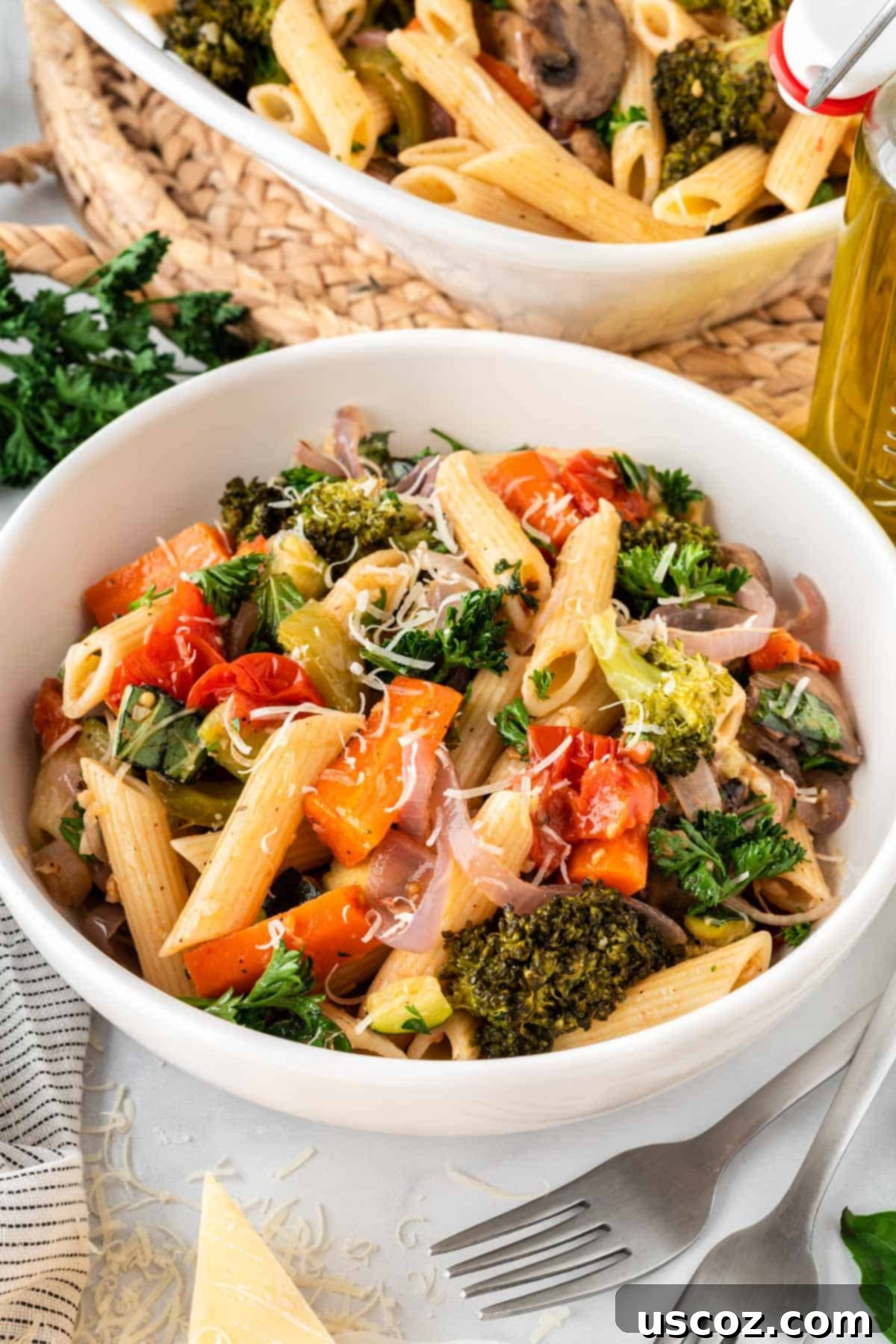
Frequently Asked Questions (FAQs)
Here are answers to some common questions about making this roasted vegetable pasta:
- Can I make this roasted vegetable pasta ahead of time? You can definitely do some prep work in advance! Chop all your vegetables and store them in airtight containers in the refrigerator a day or two before. You can also roast the vegetables ahead of time and store them. When ready to serve, simply cook the pasta, gently reheat the roasted vegetables (perhaps with a splash of olive oil), and combine. The best flavor is achieved when everything is freshly combined, but prepping ahead makes weeknight meals even faster.
- Can I use frozen vegetables for this recipe? While fresh vegetables are highly recommended for optimal flavor and texture when roasting, some frozen vegetables can work. If using frozen broccoli or bell peppers, ensure they are thawed and thoroughly patted dry before roasting to prevent excess moisture, which can lead to steaming instead of crisping. Skip frozen zucchini or mushrooms as they tend to release too much water.
- Is this recipe vegan? Yes! This roasted vegetable pasta is naturally vegan before adding the Parmesan cheese. If you wish to keep it vegan, simply omit the Parmesan or use a dairy-free Parmesan alternative.
- What kind of olive oil should I use? A good quality extra virgin olive oil is recommended for both roasting and dressing. Its robust flavor will complement the fresh ingredients beautifully.
- How do I ensure my vegetables get crispy, not soggy? The keys are high heat (425°F/220°C) and not overcrowding your baking sheets. Give the vegetables plenty of space to breathe so they can roast and caramelize rather than steam. Stirring them occasionally also helps.
More Delicious Pasta & Vegetable Recipes
If you loved this roasted vegetable pasta, be sure to check out some of our other favorite easy and flavorful recipes:
- Cream Cheese Pasta
- Butternut Squash Mac and Cheese
- Creamy Penne Pasta
- Broccoli Mac and Cheese
- Roasted Broccoli and Carrots
- Creamy Vegetable Soup
- Creamy Parmesan Sauce
- Easy Bow Tie Pasta
- Crock Pot Baked Ziti
- Vegetarian Baked Spaghetti
This roasted vegetable pasta is truly the perfect summer dinner, but honestly, it’s wonderful any time of year! It’s an effortless way to transform simple, wholesome ingredients into a satisfying and incredibly flavorful meal. So, grab those extra veggies from the farmer’s market or your own garden, and make this delicious, healthy pasta dinner tonight. Your taste buds will thank you!
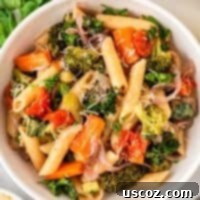
Roasted Veggie Pasta
Save RecipeSaved!
Pin Recipe
Rate Recipe
Print Recipe
Ingredients
- 1 lb penne pasta
- 1 green bell pepper, sliced
- 1 large red onion, sliced
- 1 medium zucchini, diced
- 8 oz sliced mushrooms
- 3 medium carrots, cut into strips
- 10 oz cherry tomatoes, halved
- 1 small head of broccoli, chopped into florets (around 3 cups worth)
- 1/3 cup fresh parsley, roughly chopped
- 1/2 cup fresh basil, roughly chopped
- 10 cloves garlic, minced
- olive oil
- parmesan cheese, grated fresh
Instructions
-
Preheat oven to 425 degrees F (220°C).
-
On a large baking sheet, add the bell pepper, zucchini, carrots, broccoli, and red onion. Drizzle the vegetables generously with olive oil to coat, then sprinkle on salt and pepper. Toss well to combine, ensuring all vegetables are evenly coated.
-
Roast the vegetables in the preheated oven at 425 degrees F (220°C) for 15 minutes.
-
While the first batch of vegetables is roasting, prepare your second sheet pan. Halve the cherry tomatoes and slice the mushrooms. Place them on a separate baking sheet. Toss them with olive oil, salt, and pepper as well.
-
After 15 minutes, remove the first baking sheet of vegetables from the oven, give them a good stir to ensure even roasting, then place them back in the oven for 15 more minutes.
-
Place the sheet pan with tomatoes and mushrooms in the oven at the same time as the first sheet pan for the remaining 15 minutes of the initial roast.
-
After this 15-minute interval, remove both baking sheets of vegetables. Stir them again. If the vegetables are not yet tender and slightly browned to your liking, return them to the oven for an additional 5 – 15 minutes, checking periodically. The type and size of vegetables used will affect the total cook time.
-
While the vegetables are roasting, prepare the pasta according to package instructions, cooking it to an al dente texture (firm to the bite).
-
Once the penne is done cooking, drain it well and leave the pasta in the strainer, reserving about 1 cup of the starchy pasta water.
-
Add 1 teaspoon of olive oil to the empty pot (used for the pasta) and heat it over low heat.
-
Add the minced garlic to the pot and stir constantly for 1 – 2 minutes, until it becomes fragrant. Be careful not to burn it. Add the drained pasta back into the pot, then stir in all of the finished roasted vegetables. Add the fresh basil and parsley (use more or less to taste), and toss to combine. Season with additional salt and pepper to taste, and drizzle with a little more olive oil or a splash of reserved pasta water if the pasta needs more moisture or to loosen.
-
Serve the roasted veggie pasta immediately, topped with plenty of freshly grated Parmesan cheese. Enjoy!
Nutrition
Like this recipe? Rate and comment below!
